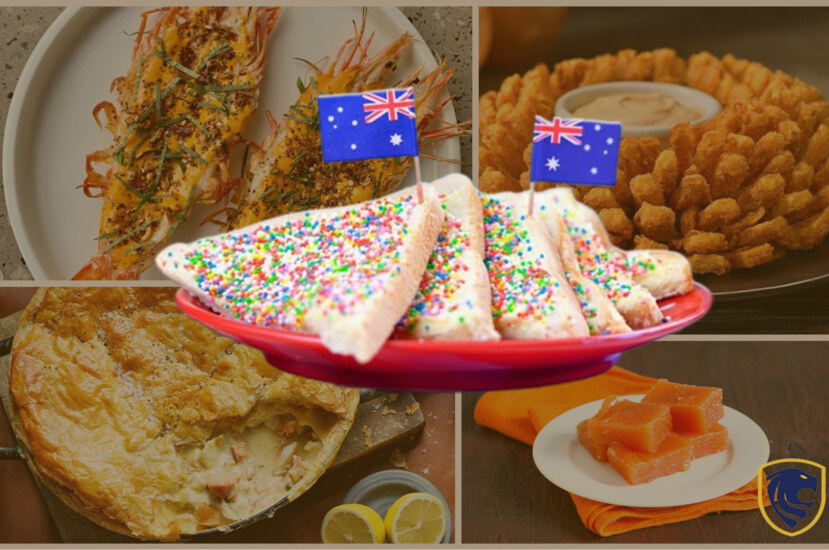Australian food is a colorful tapestry made from many cultural strands. Influenced by waves of immigration, British colonial influences, and Indigenous traditions, it represents a gastronomic development as diverse and rich as the continent’s enormous landscapes. Indigenous Australians have a strong connection to the earth as seen by their long history of bush tucker, which relies on local flora and animals. Traditional British cuisine became the mainstay once British settlers arrived. Waves of immigrants carried with them their culinary customs over time. That resulted in a patchwork of tastes that characterizes modern cuisine in Australia. While meals like barramundi and kangaroo emphasize the utilization of local foods, the renowned pork pie and Vegemite on toast exhibit the blending of British and local characteristics.
Modern Australian cuisine has been shaped by a multitude of foreign influences, coinciding with the flourishing of diversity and the culinary scene. Australian food today is a vibrant blend that embraces innovation while honoring its heritage, reflecting the country’s rich cultural diversity.
Meat Pie
With its flaky crust encasing a delicious symphony of minced beef, rich gravy, and delicate spices, the Australian beef Pie is a culinary icon. Loved all around the country, it’s a portable treat that perfectly captures comfort cuisine. There are hints of simplicity and contentment in the golden crust. It is indeed a crunchy precursor to the soft meat inside. Frequently topped with a generous portion of tomato sauce, this customary combination enhances the whole experience.

Meat Pie; Delving into the Culinary Tapestry in Australia
The Meat Pie’s widespread popularity bears witness to its ageless appeal. Moreover, it is found in both quiet outback communities and busy metropolis hubs. Savored at a neighborhood bakery or a football game, it is a gastronomic staple. The Meat Pie, a cuisine that has changed along with Australia, is a story of adaptability and tenacity. Further, It captures the spirit of Australian cuisine in every mouthful, a fusion of history, creativity, and simple delight.
Lamingtons
A delicious square of joy, the Lamington is Australia’s sweet sensation. This confectionery masterpiece consists of a sponge cake covered in chocolate frosting. Also, it is liberally topped with desiccated coconut. So, there is no surprise that it has won over hearts around the continent. While its origins are up for discussion, there’s no denying the Lamington’s legendary status in Australian cuisine. It’s a symphony of textures, soft and light on the inside and crunchy like chocolate on the exterior. With every taste, this beloved dessert, which is frequently served in morning or afternoon tea, makes people happy.

Lamingtons; Delving into the Culinary Tapestry in Australia
Lamingtons are a representation of sweet harmony, whether they are offered at a community event, a school bake sale, or a family get-together. Australians of all ages are drawn to the rich flavor. Because is concealed by the simplicity of the sponge, chocolate, and coconut combination.
Additionally, the Lamington has evolved into a blank canvas for innovation, with variants having various coatings or fillings. Whatever the twist, its core message—a celebration of kindness, community, and the Australian spirit—remains unchanged. Australia is renowned for its wide range of gastronomic delights. But the Lamington is a monument to the country’s long-lasting passion for sweets.
Pavlova
Discover the delightful world of Australian desserts with the Pavlova, which is the name of a famous Russian ballerina. It’s a meringue masterpiece. So, it is crispy on the exterior and marshmallowy on the inside. With fresh fruits and whipped cream on top, every mouthful is a sensory extravaganza of flavors and sensations. Although there is debate about the Pavlova’s origin, its status in Australian kitchens is undeniable.
It is a dessert that is always present at parties and is served on tables for special events like birthdays and holidays. The creamy, velvety center and the sweet crispness of the Pavlova combine to create a dessert of opposites. Its adaptability is evident as it can handle a variety of in-season fruits, such as strawberries and kiwis. Despite the name’s possible foreign roots, the Pavlova is considered to be a uniquely Australian invention.

Pavlova; Delving into the Culinary Tapestry in Australia
This dessert is perfect for any time of year, whether it’s served cold in the winter or warm in the summer. The Australian love affair with sweets is embodied by the Pavlova, which combines simplicity and elegance in every delicious bite. The Pavlova, a dessert that dances its way into the hearts of everyone who eats it, continues to be a star at the Australian table thanks to its ageless appeal in a country renowned for its numerous culinary offers.
Damper
Australian Damper, often known as bushman’s bread, is a staple of Australian cooking. It is uncomplicated but fulfilling, embodying the spirit of ingenuity. Traditionally baked in the ashes of campfires, Damper represents the tenacity of the first settlers. Its simple ingredients—flour, water, and a dash of salt—bely the rustic charm it adds to the table.
Just as simple as the ingredients themselves, the cooking procedure is a shared experience that promotes community. Damper is usually eaten with butter, jam, or syrup, although it can also be topped with a variety of ingredients. Serving it during a home BBQ or on a camping trip, Damper introduces tourists to Australia’s outdoor lifestyle.

Damper; Delving into the Culinary Tapestry in Australia
A lovely contrast is created between the soft inside and the crusty outside. Damper is beautiful not just because of its flavor. But also because of the memories it conjures. As a reminder of the difficulties encountered and surmounted, it serves as a concrete link to Australia’s colonial past. Even in modern times, Damper continues to be a well-liked emblem of Australian inventiveness and the country’s rich culinary history. Its ongoing appeal is a testament to Australians’ strong sense of kinship with their homeland, sense of history, and appreciation of simple pleasures.
Barramundi
Australia’s culinary jewel, barramundi, glides elegantly into the core of Australian cuisine. This fish is a seafood treat that is endemic to northern Australia. Barramundi is a seafood that embodies the purity of the nation’s seas with its somewhat sweet taste and flaky, moist texture. Barramundi may be prepared in a variety of ways, including pan-frying, baking, and grilling, which makes it a flexible option for both home cooks and chefs. Its luscious meat complements a wide range of tastes, including zesty marinades and local herbs.
Barramundi’s sustainability designates it as a seafood option that is in line with Australia’s dedication to environmental preservation. Barramundi is so popular that it may be seen on menus in both upscale and informal restaurants nationwide.

Barramundi; Delving into the Culinary Tapestry in Australia
Beyond only flavor, barramundi epitomizes the Australian attitude of supporting regional food. It links diners to the bounty of the ocean by being caught in the waterways encircling the continent. An emblem of Australia’s passion for fresh, premium seafood, barramundi may be eaten at home or in a restaurant along the coast.
In a country where a wide range of influences impact the food scene, barramundi is still a popular and uniquely Australian dish that is praised for its taste, adaptability, and role in sustainable dining.
Chiko Roll
Australian fast food gets a distinctive touch from the deep-fried pleasure known as the Australian Chiko Roll. It is a savory snack roll that was invented in the 1950s and is packed with a tasty mixture of spices, barley, carrot, cabbage, and meat. Also, it is a popular option at sporting events and takeout restaurants because of its crispy skin and meaty interior.

Chiko Roll; Delving into the Culinary Tapestry in Australia
The unique form and flavor of the Chiko Roll have made it a mainstay of Australian cuisine, particularly in informal eating settings. It’s a quick and filling snack that tastes great on the run and is frequently eaten with a side of tomato sauce. The Chiko Roll is a famous and nostalgic snack that has endured over time, despite its modest beginnings, among the varied range of Australian cuisine.




